Ann Lethbridge's Blog, page 5
March 3, 2016
Needlework
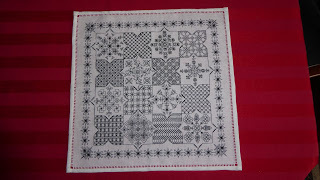 From time to time I post a needlework project I have completed. Here is a blackwork tray cloth I undertook after a class with Liz Almond. It took me ages to do.
From time to time I post a needlework project I have completed. Here is a blackwork tray cloth I undertook after a class with Liz Almond. It took me ages to do.You can imagine this on one of the ubiquitous tea trays that always make an appearance in many scenes. Er... not in my house though. No putting rings on my tray cloth, thank you very much.
As you may know, Blackwork is from an earlier era, and was simply something I wanted to try, along with the fancy edging that might well have been used in the Regency period for finishing a handkerchief. The style would have been known to our ladies of the ton, if only from the paintings in their galleries of ancestors. Not in this form though, which is a modern take on it. I can assure you, the back does not look exactly like the front.
I often read about Regency heroines who hate embroidery. Knowing how satisfying this form of creation is, to me hating embroidery or needlework, seems like us hating having new paint on the walls of our living space or even hating having a job. Embroidery was an expression of a lady's skill in making her home a comfortable and beautiful place to live. A Lady (as against a woman) would have hours of time at her disposal, and since medieval times and before, embroidery was valued for its beauty and its purpose. It was a sign of being a lady, in my opinion.
All of my heroines have some embroidery on the go, just like me. While embroidery on a gown might be done by a seamstress, embroidery on underthings, monograms on handkerchiefs, decorative pillows, embroidery on slippers, would be the privilege and pride of a lady, who would sew while her hero read to her, or a sibling did so, or while merely sitting chatting of an afternoon or evening. She would consider it her work, her contribution to her home.

Until next time.............
Published on March 03, 2016 08:02
February 29, 2016
Leap Year Special and Fashion
 Not only am I offering leap year special at BookGoodies.com, but I have an extra day to post February fashions for 1816.
Not only am I offering leap year special at BookGoodies.com, but I have an extra day to post February fashions for 1816.Promenade Dress - Ackermann's Februrary 1816
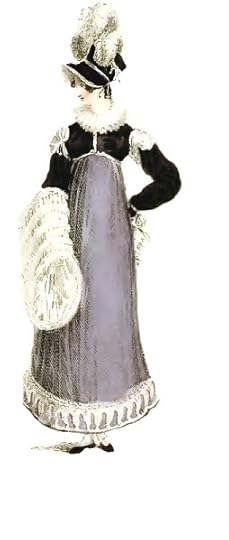 A morning dress, composed of the finest dark mulberry ladies’ cloth, finished at the bottom of the skirt with a new-invented trimming, which has an uncommonly light and pretty effect.
A morning dress, composed of the finest dark mulberry ladies’ cloth, finished at the bottom of the skirt with a new-invented trimming, which has an uncommonly light and pretty effect.A plain high body, over which is worn a spencer made of velvet one shade darker than the dress and ornamented with white satin; the half-sleeve, which is composed of white satin, and finished with white silk ornaments, is particularly novel and tasteful.
Head-dress, improved French bonnet, lined, edged, and trimmed with white satin, and ornamented with white feathers. Pointed lace ruffs. Mulberry kid sandals and gloves.
The Roxburgh muff worn with this dress is composed of white satin and swansdown, and lined with white satin. This muff, which we may venture to recommend to our fair readers as a very elegant novelty, is just introduced by Mrs. Griffin, and is, from the beauty and delicacy of its materials, calculated only for the first style of promenade or carriage dress.
We are indebted to the taste and invention of Mrs. Griffin, of Rider-street, St. James’s, for both our prints this month.
Until next time............................
Published on February 29, 2016 06:13
February 11, 2016
St. Valentine's Day
Valentine's Day is always a special day in the world of Romance, no what genre or era. In the Regency Valentine's Day was marked with not cards and chocolates as it is so often today. I love those little heart shaped boxes of chocolates. I always bought them for my daughters. I digress.
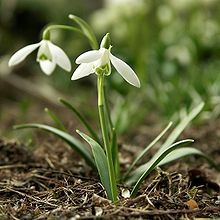
Valentine's Day was more of a "home made" affair, with posies and poems from secret admirers. I would be looking for a posy of snowdrops in February in England. A sign that spring was just around the corner and that the dude (sorry, gentleman) had gone to some trouble to seek them out.
Which would be the flower to win your heart?
Talking of winning hearts, I have joined in with several other romance authors to give away St Valentine's Day goodies. If you want to know more about the contests, check out my facebook page: https://www.facebook.com/AnnLethbridg... Here is a graphic taste of what we are up to.

Wishing you all a happy day with your significant other, chocolate, a book, a movie, or whatever else floats your romance boat
Until next time

Valentine's Day was more of a "home made" affair, with posies and poems from secret admirers. I would be looking for a posy of snowdrops in February in England. A sign that spring was just around the corner and that the dude (sorry, gentleman) had gone to some trouble to seek them out.
Which would be the flower to win your heart?
Talking of winning hearts, I have joined in with several other romance authors to give away St Valentine's Day goodies. If you want to know more about the contests, check out my facebook page: https://www.facebook.com/AnnLethbridg... Here is a graphic taste of what we are up to.

Wishing you all a happy day with your significant other, chocolate, a book, a movie, or whatever else floats your romance boat
Until next time
Published on February 11, 2016 08:01
February 8, 2016
Regency Fashion February 1816
Given that the Season has hardly started, we begin with a very elegant gown. Perhaps an invitation to a country estate came your way. If so, this would be apropos.
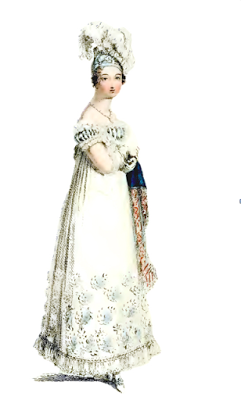 EVENING DRESS Ackermann's February 1816
EVENING DRESS Ackermann's February 1816
White crape, or lace frock, over a white satin slip; the body and sleeves are formed of a very elegant fancy material, which has just been introduced.
The body is extremely novel and elegant: we refer our readers for its form to our plate: the sleeve is very short, and, as well as the body, trimmed with blond, which is set on full.
The skirt is made a walking length, and is trimmed in a most tasteful style; but the slight view which we had of the dress will not permit us to describe it: our readers, will, however, be able to form a very correct idea of it from our plate.
Head-dress, the toque a la Rubens, composed of white lace, and ornamented with feathers and precious stones. Necklace, ear-rings, and locket, of diamonds.
White satin slippers trimmed en suite, and made, as all dress shoes now are, to come very high over the foot.
White kid gloves trimmed with tull. A French scarf, superbly embroidered at the ends, and thrown carelessly over the arm.
This dress, we understand, was invented by Mrs. Griffin for a lady of distinction; and it is certainly extremely novel and elegant.
The lack of specificity in this description is very odd. The fancy new material introduced. The body novel, but then refers the reader to a plate in which it is difficult to see because the model is turned sideways on.
Marketing 1816 style? Well done Mrs Griffin.
Until next time.
 EVENING DRESS Ackermann's February 1816
EVENING DRESS Ackermann's February 1816White crape, or lace frock, over a white satin slip; the body and sleeves are formed of a very elegant fancy material, which has just been introduced.
The body is extremely novel and elegant: we refer our readers for its form to our plate: the sleeve is very short, and, as well as the body, trimmed with blond, which is set on full.
The skirt is made a walking length, and is trimmed in a most tasteful style; but the slight view which we had of the dress will not permit us to describe it: our readers, will, however, be able to form a very correct idea of it from our plate.
Head-dress, the toque a la Rubens, composed of white lace, and ornamented with feathers and precious stones. Necklace, ear-rings, and locket, of diamonds.
White satin slippers trimmed en suite, and made, as all dress shoes now are, to come very high over the foot.
White kid gloves trimmed with tull. A French scarf, superbly embroidered at the ends, and thrown carelessly over the arm.
This dress, we understand, was invented by Mrs. Griffin for a lady of distinction; and it is certainly extremely novel and elegant.
The lack of specificity in this description is very odd. The fancy new material introduced. The body novel, but then refers the reader to a plate in which it is difficult to see because the model is turned sideways on.
Marketing 1816 style? Well done Mrs Griffin.
Until next time.
Published on February 08, 2016 08:00
January 25, 2016
Fashion January 1816
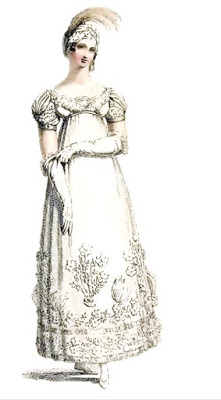 I love the embroidery on this gown.
I love the embroidery on this gown. EVENING DRESS - Ackermann's January 1816
A white crape frock over a satin slip; the frock is superbly ornamented with French Lama work in silver; the dress is cut very low all round the bosom, and the crape fronts are open at each side, so as to display the white satin one underneath.
The sleeve is an intermixture of white satin and crape; the latter full, the former tastefully ornamented with silver, to correspond with the bottom of the dress.
Head-dress, a white crape turban, ornamented with silver and a long white feather.
Necklace and ear-rings of pearl. White kid gloves, drawn nearly to the elbow, and finished at the top by a quilling of tull. White satin slippers.
This frock is also in high estimation for a ball-dress, with the hair full-dressed and pearl ornaments, or a comb composed of pearl and coloured gems.
We are indebted to the tasteful fancy of Mrs. Bean of Albemarle-street for both our dresses this month.
If you enjoy Regency romances, look out for my next book. Details about where when and what
Coming Soon:
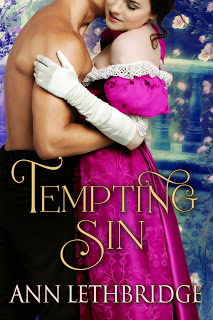
Until next time...........................................
Published on January 25, 2016 08:00
January 14, 2016
Brighton Revisted 3
 St Nicholas of Myra is an absolute treasure. It dates from the fourteenth century, though there has been a church in Brighthelstone since Saxon times. The main source of income for villagers was mackerel fishing and therefor the church is appropriately dedicated to the patron saint of fishermen and children.
St Nicholas of Myra is an absolute treasure. It dates from the fourteenth century, though there has been a church in Brighthelstone since Saxon times. The main source of income for villagers was mackerel fishing and therefor the church is appropriately dedicated to the patron saint of fishermen and children.The fact that this is the church where my mother in law was married makes it special to our family, but as a regency buff it is also special because of its association with those members of Regency society who would have attended church here during the summer months.
Here are some of the fascinating things about St Nicholas of interest to Regency aficionados. The Duke of Wellington attended the school "The Academy for Young Gentlemen" run by the vicar of St Nicholas. It was common practice for vicars to supplement their income by teaching the boys of local gentlemen at that time.
During the Regency, their were galleries in the church for local fisherman, charity pensioners and Charity-school children, while the more affluent worshiped in the box pews at ground level. These galleries were removed during a major renovation in 1853.
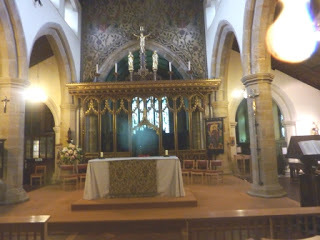 The Church acquired a new organ in 1813, instrument built by H.C.Lincoln and pipes by Bevington.
The Church acquired a new organ in 1813, instrument built by H.C.Lincoln and pipes by Bevington.If you have an interest in seeing the church before the restoration I have a picture showing the pews which hints at the galleries above, but the quality is such that I cannot include it here.
What does remain is the fifteenth century screen which is absolutely beautiful. It is thought to have come from East Anglia. Parts of it were destroyed when the Cromwellians had a go at it, it was restored in the late 19th century.
While the stone pillars and arches were also there, the Galleries aforementioned were on a level with the festoons of the screen, making the church a much smaller and more crowded place.
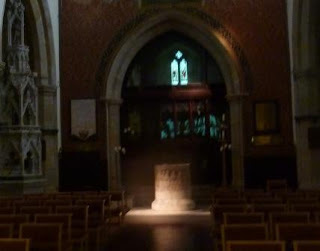 The Font, pictured here is from the 12th Century.
The Font, pictured here is from the 12th Century.Made from a solid block of Caen Stone it is known as the finest piece of Norman carving in Sussex.
Of course my big question was, did all those Regency notables worship here at the only church in what became Brighton. The local history says it was too far up the hill.
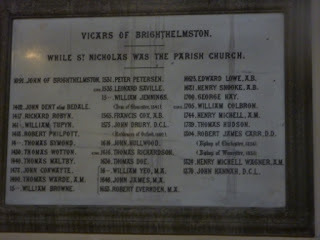 A chapel was therefore built nearer to the Pavillion. The Prince Regent rented one of the pews at 13 guineas a year.
A chapel was therefore built nearer to the Pavillion. The Prince Regent rented one of the pews at 13 guineas a year.However the Vicar at the time, preached a sermon about King David seducing Bathsheba and sending Prinny off from there in high dudgeon, never to return.
At the time of the Regency, the bell tower sported 8 bells and was known for marathon peals, ringing as many as 11,088 changes over six hours in 1779. It became the first 10 bell tower in 1818.
Until next time................
Published on January 14, 2016 08:20
January 12, 2016
Fashion - January 1816
I do hope you all enjoyed your celebration of the new year as we move into 1816 -- oops, earth to Ann, it is really 2016. How quickly time flies.
However, we will go back in time and take a peek at what the ladies were wearing back then. December 1815 gave us a walking dress, Ackermann's in January puts us in a carriage, surprisingly however, the colour is the same.
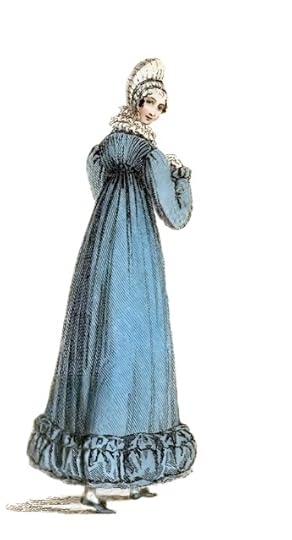 CARRIAGE DRESS.
CARRIAGE DRESS.
High dress, composed of the finest dark blue ladies’ cloth; it is made up to the throat, but without a collar, has a slight fullness in the back, and falls very much off the shoulder;
the front is tight to the shape, and the waist very short.
The trimming is dark blue satin, to correspond; it is cut byas, laid on double and very full:
long plain sleeve, finished at the wrist with satin;
French ruff of very rich lace. Head-dress a la mode de Paris; it is a cap composed of white lace, and ornamented with two rolls of ribbon to correspond: the form of this cap is in the highest degree original.
Gloves white kid. Sandals blue kid.
I find the shape of the dress very attractive, though to me it seems more like a "coat-dress" something I really liked wearing back in the day (my day).
The cap reminds me of a Spanish comb (peineta).
I think it preferable to December's offering, but it is all about taste.
Until next time........
However, we will go back in time and take a peek at what the ladies were wearing back then. December 1815 gave us a walking dress, Ackermann's in January puts us in a carriage, surprisingly however, the colour is the same.
 CARRIAGE DRESS.
CARRIAGE DRESS.High dress, composed of the finest dark blue ladies’ cloth; it is made up to the throat, but without a collar, has a slight fullness in the back, and falls very much off the shoulder;
the front is tight to the shape, and the waist very short.
The trimming is dark blue satin, to correspond; it is cut byas, laid on double and very full:
long plain sleeve, finished at the wrist with satin;
French ruff of very rich lace. Head-dress a la mode de Paris; it is a cap composed of white lace, and ornamented with two rolls of ribbon to correspond: the form of this cap is in the highest degree original.
Gloves white kid. Sandals blue kid.
I find the shape of the dress very attractive, though to me it seems more like a "coat-dress" something I really liked wearing back in the day (my day).
The cap reminds me of a Spanish comb (peineta).
I think it preferable to December's offering, but it is all about taste.
Until next time........
Published on January 12, 2016 08:00
December 28, 2015
Farewell to 1815
Our last fashion blog for the year.

Walking Dress, December 1815
Not my favourite by a long way, despite the glowing recommendation at the end of the description. As always it gives us a voyeuristic sense of the time.
The description is from the Ackermann's December 1815 edition.
Pelisse, of walking length, composed of blue twilled sarsnet, fastened down the front with large bows of white satin ribbon, and ornamented at the feet with a border of leaves formed of the same sarsnet, edged with white satin:
the bottom of the pelisse, trimmed with white satin, is drawn into small festoons; sleeve ornamented at the shoulder and the hand to correspond;
a French embroidered ruff.
A French hat composed of the blue twilled sarsnet, trimmed with white satin edged with blue, and decorated with a large plume of ostrich feathers.
An Indian shawl of crimson silk, richly embroidered in shaded silks. The pocket-handkerchief French cambric, embroidered at the corners.
Shoes, blue morocco, tied with bows high upon the instep. Stockings with embroidered clocks. Gloves, York tan.
The silver-striped French gauze is a novel and elegant article, which, fashioned by the ever-varying and approved taste of Mrs. Bean, requires to be viewed, before a just idea can be received of its fascinating effects; it is allowed to be the lightest and most splendid costume ever yet presented by the amateur to the votaries of fashion.
I do hope you all had a very happy Christmas tide, if it is something you celebrate.
I am looking forward to embarking with you on a new year of fashion, travel and books.

Walking Dress, December 1815
Not my favourite by a long way, despite the glowing recommendation at the end of the description. As always it gives us a voyeuristic sense of the time.
The description is from the Ackermann's December 1815 edition.
Pelisse, of walking length, composed of blue twilled sarsnet, fastened down the front with large bows of white satin ribbon, and ornamented at the feet with a border of leaves formed of the same sarsnet, edged with white satin:
the bottom of the pelisse, trimmed with white satin, is drawn into small festoons; sleeve ornamented at the shoulder and the hand to correspond;
a French embroidered ruff.
A French hat composed of the blue twilled sarsnet, trimmed with white satin edged with blue, and decorated with a large plume of ostrich feathers.
An Indian shawl of crimson silk, richly embroidered in shaded silks. The pocket-handkerchief French cambric, embroidered at the corners.
Shoes, blue morocco, tied with bows high upon the instep. Stockings with embroidered clocks. Gloves, York tan.
The silver-striped French gauze is a novel and elegant article, which, fashioned by the ever-varying and approved taste of Mrs. Bean, requires to be viewed, before a just idea can be received of its fascinating effects; it is allowed to be the lightest and most splendid costume ever yet presented by the amateur to the votaries of fashion.
I do hope you all had a very happy Christmas tide, if it is something you celebrate.
I am looking forward to embarking with you on a new year of fashion, travel and books.
Published on December 28, 2015 08:00
December 15, 2015
Fashion - December 1815
Evening Gown from Ackerman's
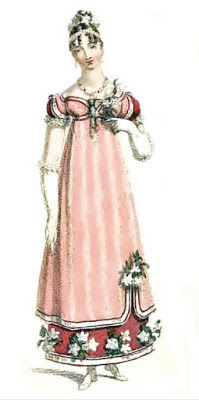
A CRIMSON satin slip, underneath a frock of three-quarters length made of the silver-striped French gauze; the slip ornamented at the feet with clusters of flowers, and a narrow border of white satin edged with crimson ribbon:
the frock has a border of white satin, edged to correspond, and is drawn up in the Eastern style, confined by a cluster of flowers.
The body of the dress has open fronts, with a stomacher, which are severally trimmed en suite; short open sleeve, to correspond with a quilling of tull round the arm.
Head-dress a la Chinoise, composed of pearl; the hair braided, and ornamented with a wreath of flowers.
Ear-rings and drops, pearl; necklace, the French negligée.—Gloves, French kid, worn below the elbow, and trimmed with a quilling of tull.
Sandals, white kid.
What a pretty dress to wear for a Christmas party, don't you think?

A CRIMSON satin slip, underneath a frock of three-quarters length made of the silver-striped French gauze; the slip ornamented at the feet with clusters of flowers, and a narrow border of white satin edged with crimson ribbon:
the frock has a border of white satin, edged to correspond, and is drawn up in the Eastern style, confined by a cluster of flowers.
The body of the dress has open fronts, with a stomacher, which are severally trimmed en suite; short open sleeve, to correspond with a quilling of tull round the arm.
Head-dress a la Chinoise, composed of pearl; the hair braided, and ornamented with a wreath of flowers.
Ear-rings and drops, pearl; necklace, the French negligée.—Gloves, French kid, worn below the elbow, and trimmed with a quilling of tull.
Sandals, white kid.
What a pretty dress to wear for a Christmas party, don't you think?
Published on December 15, 2015 08:00
December 3, 2015
Brighton Revisited 3
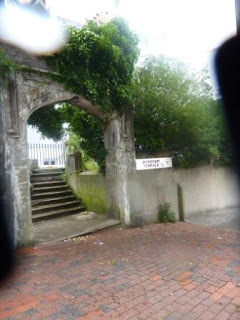
The main purpose of this trip was to revisit Brighton as the place where my mother-in-law, Kit, grew up. So after wandering along marine parade and looking at the sea, we headed up Great East Street, avoiding the lure of The Lanes, and along North Street which has always been an important shopping area. It was here that we come to No. 1 Wykeham (said Wickham like in Pride and Prejudice) Terrace.
This gothic looking entrance is quite novel is it not. The terrace is not accessible by road at the front, but merely by this set of steps leading off the path or sidewalk as we call it in North America.
When you see the individual houses in the terrace I think you might have trouble seeing it as a holiday boarding house. I know I did.
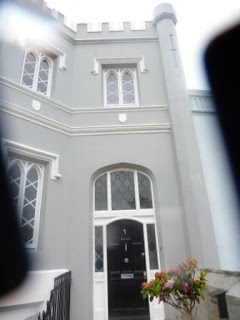
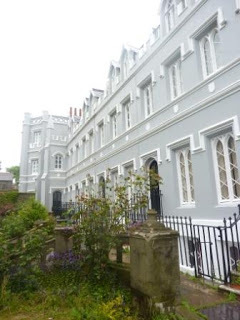 To me it looks more like a small town house. Here we are looking down the row. These are not large places. The doors are only two windows apart though there are four floors, one you can see within the area, as sort of basement and another up in the eaves with dormer windows in addition to the two main floors. On our right is number 1 in a sort of tower. This made it somewhat bigger that those in the flat part of the row.
To me it looks more like a small town house. Here we are looking down the row. These are not large places. The doors are only two windows apart though there are four floors, one you can see within the area, as sort of basement and another up in the eaves with dormer windows in addition to the two main floors. On our right is number 1 in a sort of tower. This made it somewhat bigger that those in the flat part of the row.  I took these views for my children to have a sense of what their Grannie was talking about when she talked about her life growing up.
I took these views for my children to have a sense of what their Grannie was talking about when she talked about her life growing up.She lived here until she was married. She always talked about deciding whether to get a tattoo of a blue bird on her right breast, or to get married (she was known as a bit of a lad as a girl) and I think the decision had something to do with the cost, tattoos being expensive. Well Sammy, my father-in-law must have talked her out of the tattoo, because later in life she always joked that given her increased girth after seven children, the tattoo would have gone from being a bluebird to a "bloody great eagle".
Personally I think she still regretted that tatto.
As you can see from the shared garden, this terrace is on quite a hill. No, it is not me having had too much to drink, this was taken before lunch. lol.
When Kit talked about walking up the hill to the church on her wedding day, I never imagined this.
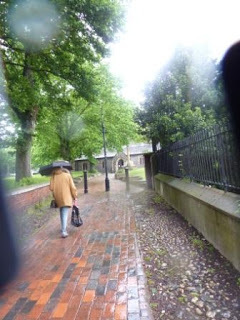
By the time we had taken these photos the heavens opened and so we decided to follow in Kit's footsteps. In the photo on the right to the right of the picture is the fence between us and Wykeham Terrace and to the left the is North Street, which eventually took off to London.
So, on her wedding day, September 26, 1931, my mother-in-law walked up this hill in her wedding dress to get married. fortunately it wasn't raining on that day.
But what on earth has this got to do with the Regency, you ask, after my trip down memory lane?
Just wait until you see the church. Next time......
Published on December 03, 2015 08:23



